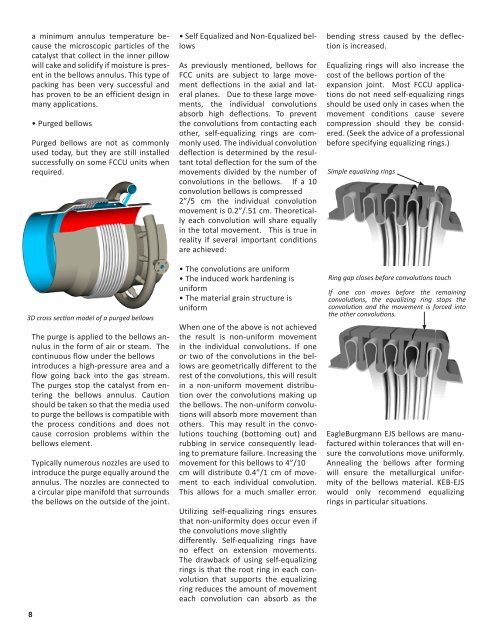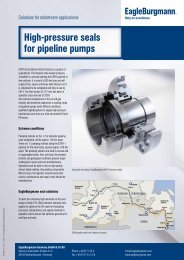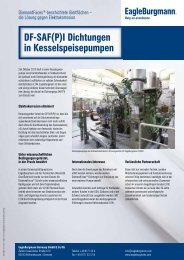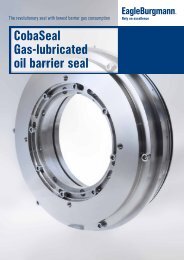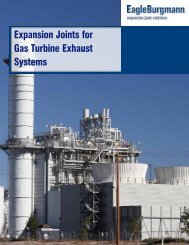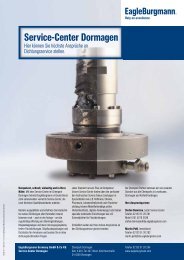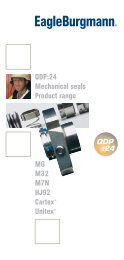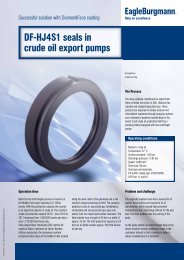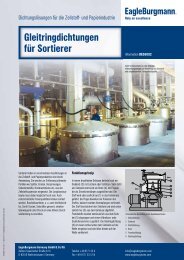Emergency Services - EagleBurgmann
Emergency Services - EagleBurgmann
Emergency Services - EagleBurgmann
Create successful ePaper yourself
Turn your PDF publications into a flip-book with our unique Google optimized e-Paper software.
a minimum annulus temperature because<br />
the microscopic particles of the<br />
catalyst that collect in the inner pillow<br />
will cake and solidify if moisture is present<br />
in the bellows annulus. This type of<br />
packing has been very successful and<br />
has proven to be an efficient design in<br />
many applications.<br />
3D cross section model of a purged bellows<br />
8<br />
• Purged bellows<br />
Purged bellows are not as commonly<br />
used today, but they are still installed<br />
successfully on some FCCU units when<br />
required.<br />
The purge is applied to the bellows annulus<br />
in the form of air or steam. The<br />
continuous flow under the bellows<br />
introduces a high-pressure area and a<br />
flow going back into the gas stream.<br />
The purges stop the catalyst from entering<br />
the bellows annulus. Caution<br />
should be taken so that the media used<br />
to purge the bellows is compatible with<br />
the process conditions and does not<br />
cause corrosion problems within the<br />
bellows element.<br />
Typically numerous nozzles are used to<br />
introduce the purge equally around the<br />
annulus. The nozzles are connected to<br />
a circular pipe manifold that surrounds<br />
the bellows on the outside of the joint.<br />
• Self Equalized and Non-Equalized bellows<br />
As previously mentioned, bellows for<br />
FCC units are subject to large movement<br />
deflections in the axial and lateral<br />
planes. Due to these large movements,<br />
the individual convolutions<br />
absorb high deflections. To prevent<br />
the convolutions from contacting each<br />
other, self-equalizing rings are commonly<br />
used. The individual convolution<br />
deflection is determined by the resultant<br />
total deflection for the sum of the<br />
movements divided by the number of<br />
convolutions in the bellows. If a 10<br />
convolution bellows is compressed<br />
2”/5 cm the individual convolution<br />
movement is 0.2”/.51 cm. Theoretically<br />
each convolution will share equally<br />
in the total movement. This is true in<br />
reality if several important conditions<br />
are achieved:<br />
• The convolutions are uniform<br />
• The induced work hardening is<br />
uniform<br />
• The material grain structure is<br />
uniform<br />
When one of the above is not achieved<br />
the result is non-uniform movement<br />
in the individual convolutions. If one<br />
or two of the convolutions in the bellows<br />
are geometrically different to the<br />
rest of the convolutions, this will result<br />
in a non-uniform movement distribution<br />
over the convolutions making up<br />
the bellows. The non-uniform convolutions<br />
will absorb more movement than<br />
others. This may result in the convolutions<br />
touching (bottoming out) and<br />
rubbing in service consequently leading<br />
to premature failure. Increasing the<br />
movement for this bellows to 4”/10<br />
cm will distribute 0.4”/1 cm of movement<br />
to each individual convolution.<br />
This allows for a much smaller error.<br />
Utilizing self-equalizing rings ensures<br />
that non-uniformity does occur even if<br />
the convolutions move slightly<br />
differently. Self-equalizing rings have<br />
no effect on extension movements.<br />
The drawback of using self-equalizing<br />
rings is that the root ring in each convolution<br />
that supports the equalizing<br />
ring reduces the amount of movement<br />
each convolution can absorb as the<br />
bending stress caused by the deflection<br />
is increased.<br />
Equalizing rings will also increase the<br />
cost of the bellows portion of the<br />
expansion joint. Most FCCU applications<br />
do not need self-equalizing rings<br />
should be used only in cases when the<br />
movement conditions cause severe<br />
compression should they be considered.<br />
(Seek the advice of a professional<br />
before specifying equalizing rings.)<br />
Simple equalizing rings<br />
Ring gap closes before convolutions touch<br />
If one con moves before the remaining<br />
convolutions, the equalizing ring stops the<br />
convolution and the movement is forced into<br />
the other convolutions.<br />
<strong>EagleBurgmann</strong> EJS bellows are manufactured<br />
within tolerances that will ensure<br />
the convolutions move uniformly.<br />
Annealing the bellows after forming<br />
will ensure the metallurgical uniformity<br />
of the bellows material. KEB-EJS<br />
would only recommend equalizing<br />
rings in particular situations.


